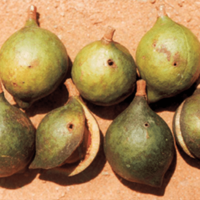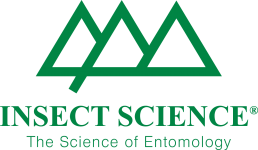Host plants
Macadamia is evidently a major host of this moth in southern Africa and, apart from a single report of its occurrence on citrus many years ago, it has not been recorded from any other cultivated crop or indigenous host in the region. It has been recorded from litchi in Malawi and guava in Madagascar.
Damage
Damage before shell hardening is caused by the larvae which bore into the fruit. In small nuts the entire kernel is eaten, whereas in large fruit part of the kernel may remain. A larva may consume several small nuts by moving from one fruit to another. This type of damage is usually relatively small (less than 5%) and because of large volume of flowers and small nuts produced by macadamia trees early in the season, most trees are able to compensate for damage. Fruit with hardened shells cannot be penetrated, in which case the larvae feed on the inside of the husk. Damaged nuts are shed by the tree. If vascular bundles on the insides of the husks of fully developed nuts are damaged by larval feeding, all further development of a macadamia nut is immediately arrested. Outwards, these nuts resemble undamaged nuts and processor costs normally escalate because they are processed as such. These nuts are normally removed from the packing line by using water baths.
The macadamia nut borer is regarded as a major pest of macadamia in the cooler production areas of South Africa. It is also a quarantine pest and mitigating practices for control has to be carried out to enable export of macadamia to certain destinations.
Life history
The life history of this moth on macadamia in southern Africa has not been studied in any detail and much of the following information is from an account by La Croix & Thindwa (1986) of the moth in Malawi.
Eggs are laid singly on young fruit, usually on the upper half of the fruit in the narrow space between adjacent fruits; each female may lay between 170-300 eggs in her lifetime. The eggs reportedly take 7-12 days to hatch, after which the young larvae bore into the young fruit. The larval stage, at 27 ˚C, has been shown to be complete in about 24 days. Larvae either pupate in fruit which drop from trees or leave the nut to pupate in the soil, in which case they crawl down the tree or drop to the ground on a thread. Moths are active at night and rest in a secluded place by day.
Natural enemies
No information is available on the natural enemies of the macadamia nut borer in southern Africa. Several parasitic wasps of the families Chalcididae, Braconidae and Ichneumonidae have been recorded from Malawi by La Croiix & Thindwa (1986) in addition to the tricogrammatid egg parasitoid Trichogrammatoidea cryptophlebia Nagaraja. The latter wasp is also known from southern Africa as a parasitoid of the false codling moth and in all probability also attacks the macadamia nut borer in this region.
Management
The macadamia nut borer is a notorious pest and often has to be controlled in orchards on a regular basis. Pheromones are commercially available to facilitate threshold-based control. For effective decision making, supporting information regarding flight peaks should ideally be combined with egg counts on the fruit. Essentially, the most vulnerable stage in the development of this insect is the newly hatched larvae. Conventional control is based on high volume sprays such as synthetic pyrethroids and insect growth regulators. More recently, increasingly refined products containing pheromones in combination with insecticide and products aimed at mating disruption have become commercially available.






